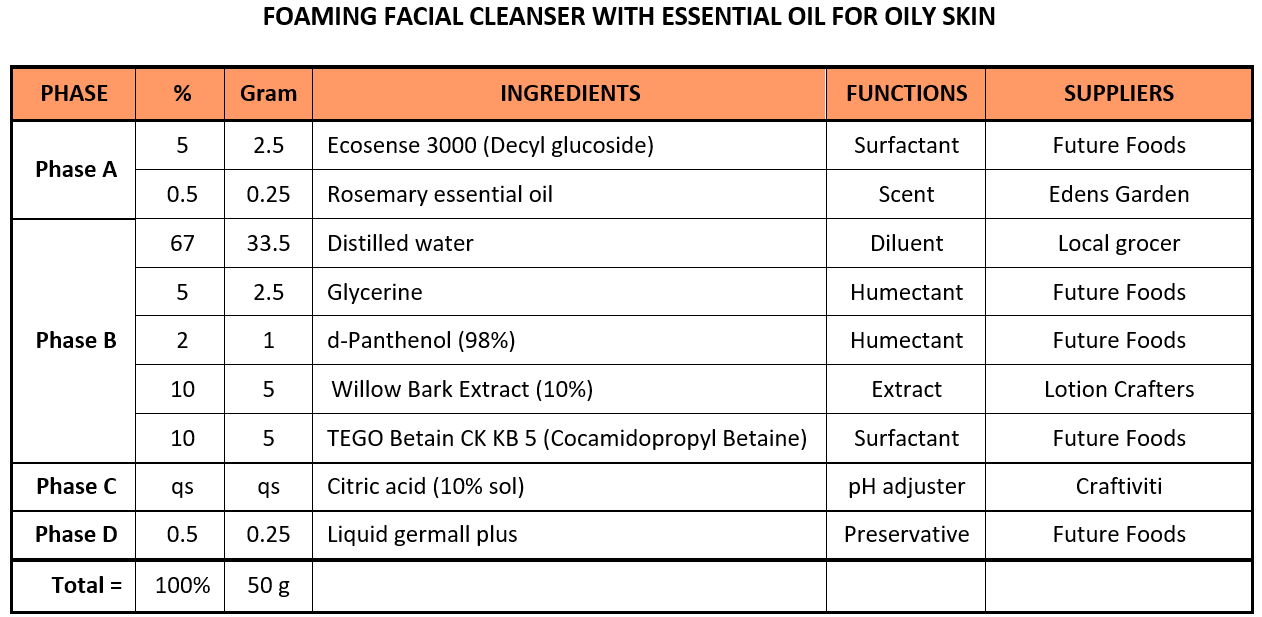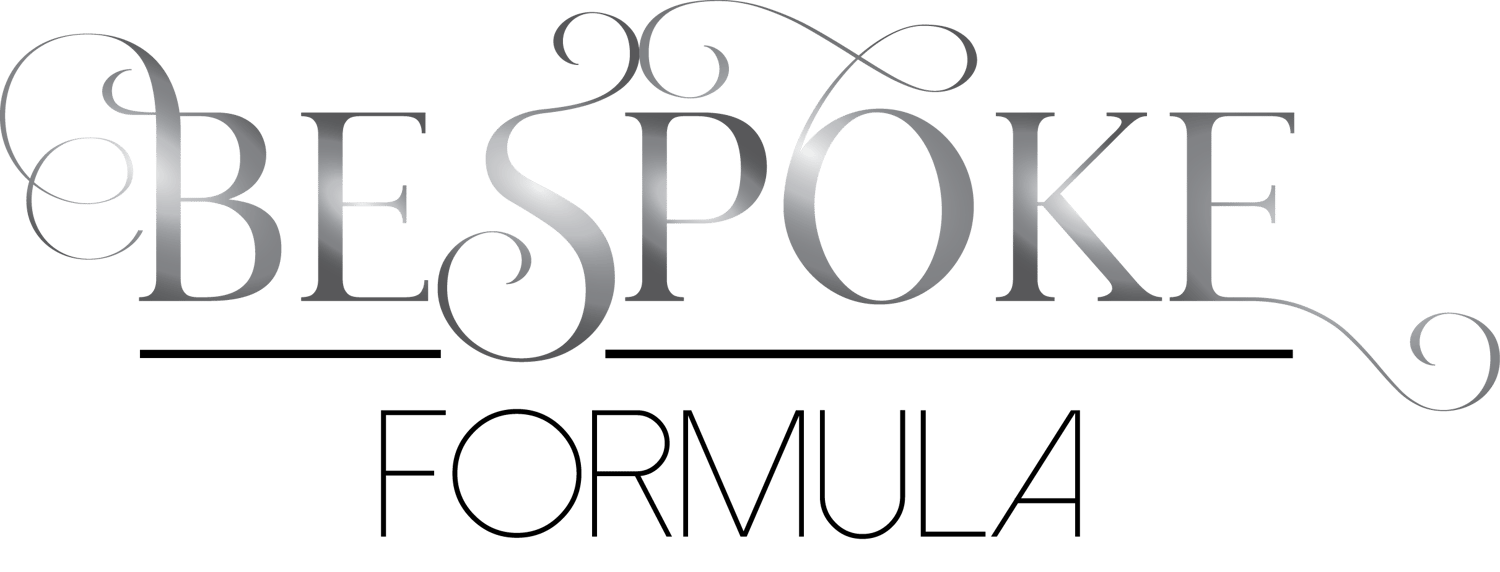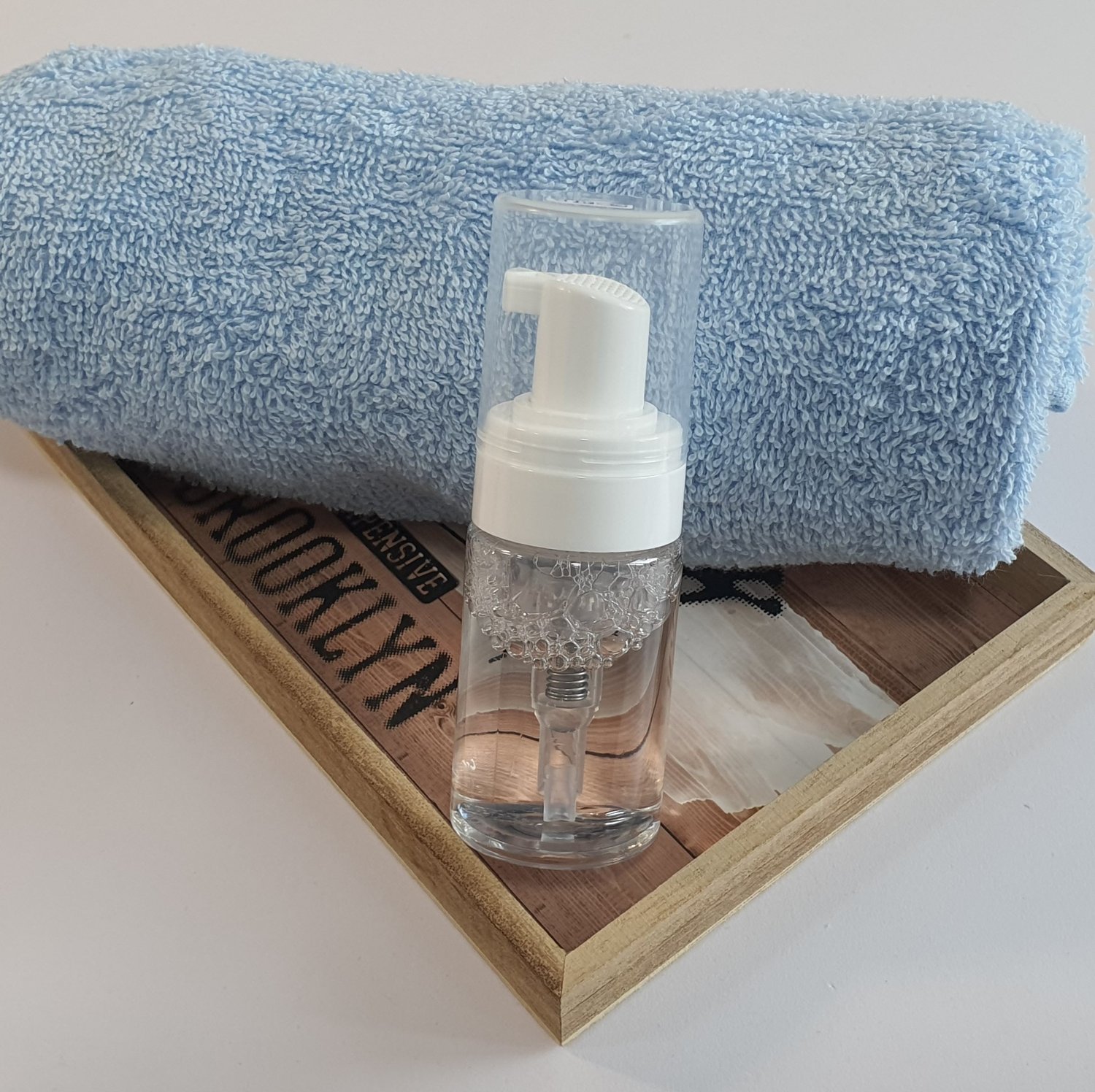Let’s make a foaming facial cleanser for oily skin.
In today’s formula, I will be using essential oils to scent the product.
As you know, oil and water do not mix, at least not without assistance. They require a solubilizer, emulsifier, or dispersant to form a homogenous mixture, but there are differences between a solubilizer, emulsifier, and dispersant, which I will speak a bit more about in a future video.
A solubilizer is an ingredient that helps to make otherwise insoluble liquids, soluble in water. Solubilizers are widely used in cosmetics to uniformly dissolve or disperse a small amount (0.1 – 2%) of essential oils, fragrance oils, or preservatives in water-based products.
Polysorbate 20 and PEG-40 hydrogenated castor oil are the two most commonly used solubilizers in cosmetics.
In the formula below, we do not need an additional ingredient called a solubilizer to solubilize our essential oil. By carefully selecting the right surfactant, we do not need a solubilizer. Decyl glucoside is not only a mild non-ionic cleansing agent but can also act as a solubilizer. With a carbon chain length of C8-C12, it has a superior solubility compared to coco glucoside or lauryl glucoside.
If you are not a fan of essential oils, you can definitely skip them in the formula. But if you still want some scent in your cleanser without using essential oils, then you can use hydrosol.
KEY INGREDIENTS
1. Ecosense 3000 (Decyl Glucoside)
Decyl glucoside is a biodegradable, green, non-ionic, natural surfactant derived from corn sugars. It has a great foaming capacity and is mild and gentle on the skin. It can be used as the only surfactant or as a co-surfactant in cleansing formulas.
Usage rate : 1-15% (Facial Wash)
Active matter : 51-55%
INCI : Decyl glucoside, aqua
pH : 12
Tradenames : There are many tradenames for decyl glucoside, with different manufacturers and varieties of ASM concentration.
2. TEGO Betain CK KB 5 (Cocamidopropyl Betaine)
Cocamidopropyl betaine is a very mild amphoteric surfactant derived from coconut oil. It is suitable for all cleansing products, especially body washes, shampoos, bubble baths, cleansing lotions, creams, hand soaps, baby products, hair conditioners, cream rinses, and mild facial washes. It is frequently used as a secondary surfactant, which means it should be blended with other surfactants in the formula for best results, although it also works as a sole surfactant.
Usage rate : 10% - 20% (Facial Wash)
Active matter : 29-32%
INCI : Aqua, Cocamidopropyl betaine, Sodium chloride
pH : 4-6
Tradename : Like decyl glucoside, cocamidopropyl betaine too comes with different tradenames, different manufacturers, and a variety of ASM concentrations and blends. There is also powdered cocamidopropyl betaine. To add to the confusion, there is also a surfactant called coco betaine, which is very often confused with cocamidopropyl betaine. Coco-betaine and cocamidopropyl betaine are not the same product. So, look carefully when purchasing this surfactant.
3. D-Panthenol (98%)
Panthenol is a versatile ingredient used in hair and skin care. It has anti-inflammatory, hydrating, conditioning, and anti-static properties. Panthenol can be found in both rinse-off and leave-on hair care products. It is a water-soluble ingredient, relatively stable to oxygen and light, stable in neutral or slightly acidic aqueous solutions (pH 4-6), and prolong exposure to heat exceeding 70°-75° C may cause racemization.
Usage rate : 0.1-2%
INCI : Panthenol, aqua
Panthenol also comes in various concentrations.
4. Liquid Germall Plus
Liquid Germall Plus is used as a preservative in cosmetic formulations such as lotions, conditioners, shampoos, creams, body washes, body sprays, and other surfactant-based products. It is water-soluble, one of the most effective antimicrobials, and inhibits the growth of gram-positive and gram-negative bacteria, yeasts, and molds.
Usage rate : 0.1-0.5%
INCI : Propylene Glycol, Diazolidinyl Urea, Iodopropynyl Butylcarbamate
Other tradenames : A2 Plus Liquid, SupGuard® GM-BP, Saliplus Liquid
5. Willow Bark Extract 10%
Willow Bark Extract 10% (which contains 10% salicylates) is a source of natural salicylic acid-like ingredients, which have been shown to contribute effects similar to those seen from synthetic salicylic acid. Salicylic acid, when used in cosmetic formulations at 0.5% to 1%, enhances skin cell turnover by promoting exfoliation, resulting in a general improvement in the appearance of the skin and a smoothing effect with an accompanying reduction of fine lines and wrinkles.

INCI : Aqua, Salix Nigra (Willow) Bark Extract

PROCEDURE
Step 1
First, weigh Phase A in a container and mix well.
Step 2
Weigh Phase B in a separate container. Stir until well mixed.
Step 3
Then, add Phase B to Phase A. Stir until well mixed.
Step 4
Next, check the pH. If required, adjust the pH to be between 5 – 5.5 by using a citric acid 10% solution.
Step 5
Finally, add the preservative to the mixture, mix well, and check the pH again. Adjust if necessary.
Step 6
Pour your mixture into a foaming bottle.
Notes
- The decyl glucoside (51% active matter) will be able to solubilize the rosemary essential oil and produce a clear solution. 0.5% is a good starting point. Using different essential oils may affect the solubilization and clarity of your foaming cleanser. You may need to reduce the amount of essential oil used to achieve a clear solution. Adjust accordingly based on the essential oil used.
- You can replace the water with rosemary hydrosol if you do not want to use the essential oil.
- You can use lactic acid to lower the pH as an alternative to citric acid.
- The use of foaming bottle is a must in this case. The foaming bottle introduces air into the product and produces foam with a reduced surfactant concentration. This unique cosmetic bottle which contains a ‘water-like’ product that is then transformed into foam. No other types of bottles can do that. You may still use the product without the foaming bottle, but it will behave more like a watery liquid soap.
- Usage of 5% willow bark extract 20% is equivalent to 1% salicylic acid if you are using a different concentration of willow bark extract.
Don't forget to look out for our next post on more formulas.
Happy learning!


